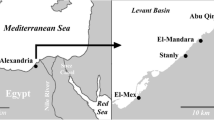Abstract
Interstitial crustaceans were collected from a grid of shallow sampling wells penetrating the alluvial floodplain aquifer (ca. 10 m × 5 km × 10 km) of the Flathead River, Montana, USA. Eighteen taxa were identified, which collectively encompassed a range of hypogean-epigean affinities. The subterranean amphipod Stygobromus spp., the most common crustacean, occurred in all wells but was rare in the channel well. When well data were pooled into ‘habitat types’ (channel, bank, near-, central-, and far-floodplain), distinct faunal patterns were apparent. Crustaceans constituted an increasing percentage of the total interstitial fauna from the channel to the near-floodplain, then maintained similar relative abundance levels with increasing distance from the river. Stygobionts attained maximum values at near- and central-floodplain habitats where copepods and ostracods dropped to the lowest levels. Distribution and abundance patterns of Crustacea at the floodplain scale are structured by hydrogeologic and geomorphic processes reflected only in part by distance from the river channel. The flood plain appears to contain a latticework of alluvial-filled paleochannels of high hydraulic conductivity that induce spatial discontinuities within the aquifer and that may play an important role in determining crustacean distribution patterns.
Similar content being viewed by others
References
Creuzé des Châtelliers, M., 1991. Geomorphological processes and discontinuities in the macrodistribution of the interstitial fauna. A working hypothesis. Verh. int. Ver. Limnol. 24: 1609–1612.
Gauch, H. G., Jr., 1982. Multivariate analysis in community ecology. Cambridge Univ. Press, Cambridge, 298 pp.
Hill, M. O., 1979. TWINSPAN-a FORTRAN program for arranging multivariate data in an ordered two-way table by classification of the individuals and attributes. Cornell Univ. Press, Ithaca, New York.
Marmonier, P., M. J. Dole-Olivier & M. Creuzé des Châtelliers, 1992. Spatial distribution of interstitial assemblages in the floodplain of the Rhône River. Regulated Rivers 7: 75–82.
Marmonier, P. & J. V. Ward, 1990. Superficial and interstitial Ostracoda of the South Platte River (Colorado, USA) — Systematics and biogeography. Stygologia 5: 225–239.
Stanford, J. A. & J. V. Ward, 1988. The hyporheic habitat of river ecosystems. Nature 335: 64–66.
Ter Braak, C. J. F., 1988. CANOCO-a FORTRAN program for canonical community ordination by (partial) (detrended) (canonical) correspondence analysis, principal components analysis and redundancy analysis (version 2.2). Agricultural Mathematics Group, Wageningen, The Netherlands, 95 pp.
Ward, J. V., 1989. The four-dimensional nature of lotic ecosystems. J. N. Am. Benthol. Soc. 8: 2–8.
Ward, J. V. & N. J. Voelz, 1990. Gradient analysis of interstitial meiofauna along a longitudinal stream profile. Stygologia 5: 93–99.
Whittaker, R. H., 1975. Communities and ecosystems. Macmillan, New York, 385 pp.
Author information
Authors and Affiliations
Rights and permissions
About this article
Cite this article
Ward, J.V., Stanford, J.A. & Voelz, N.J. Spatial distribution patterns of Crustacea in the floodplain aquifer of an alluvial river. Hydrobiologia 287, 11–17 (1994). https://doi.org/10.1007/BF00006892
Issue Date:
DOI: https://doi.org/10.1007/BF00006892




